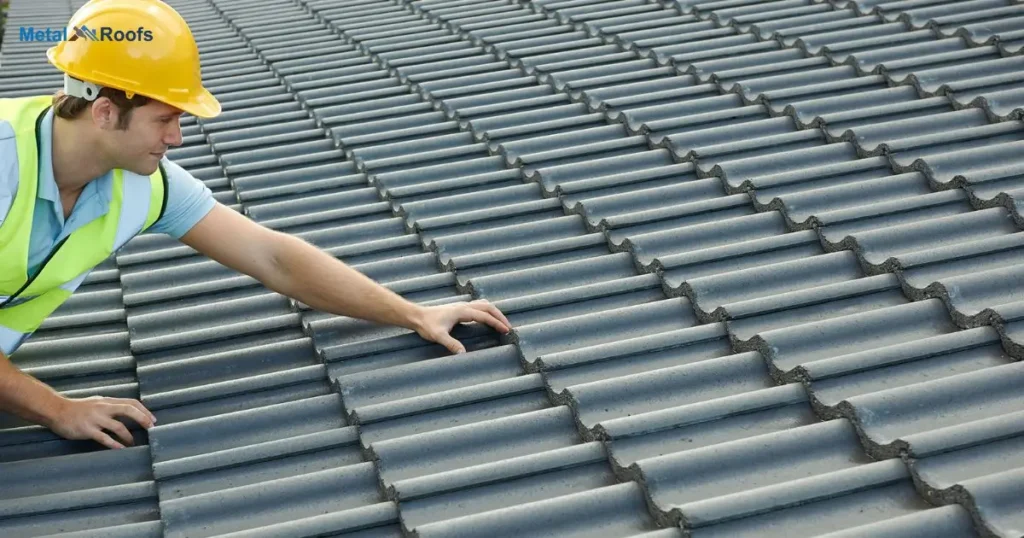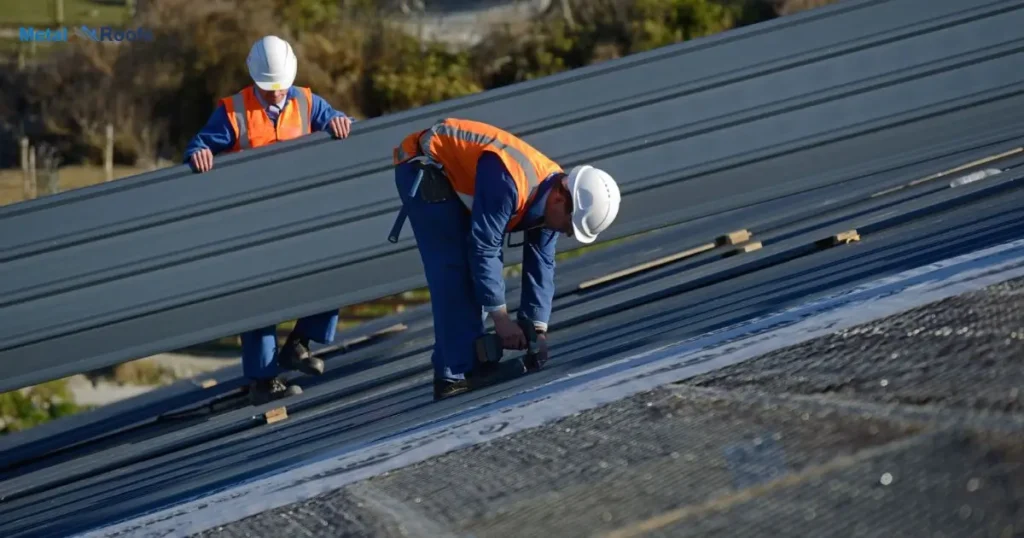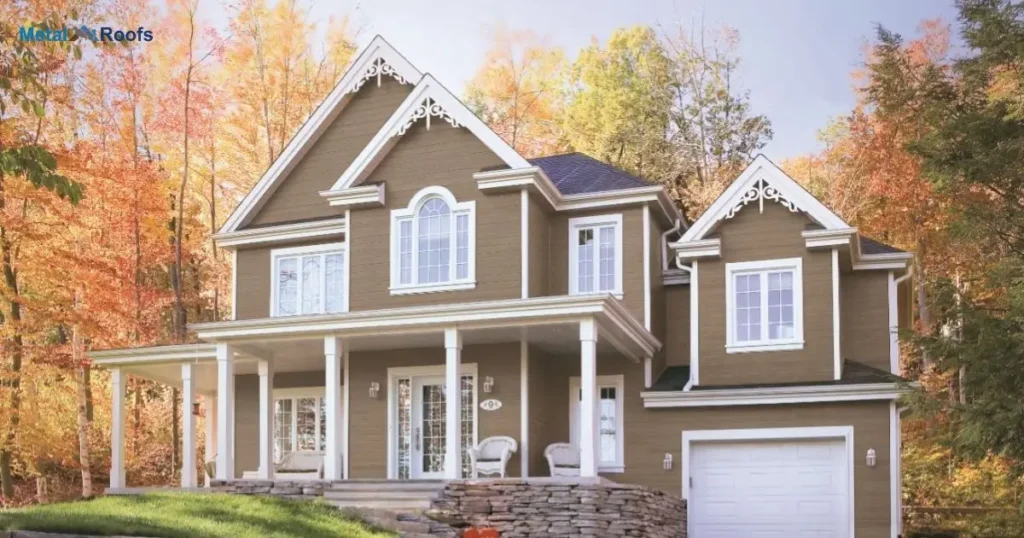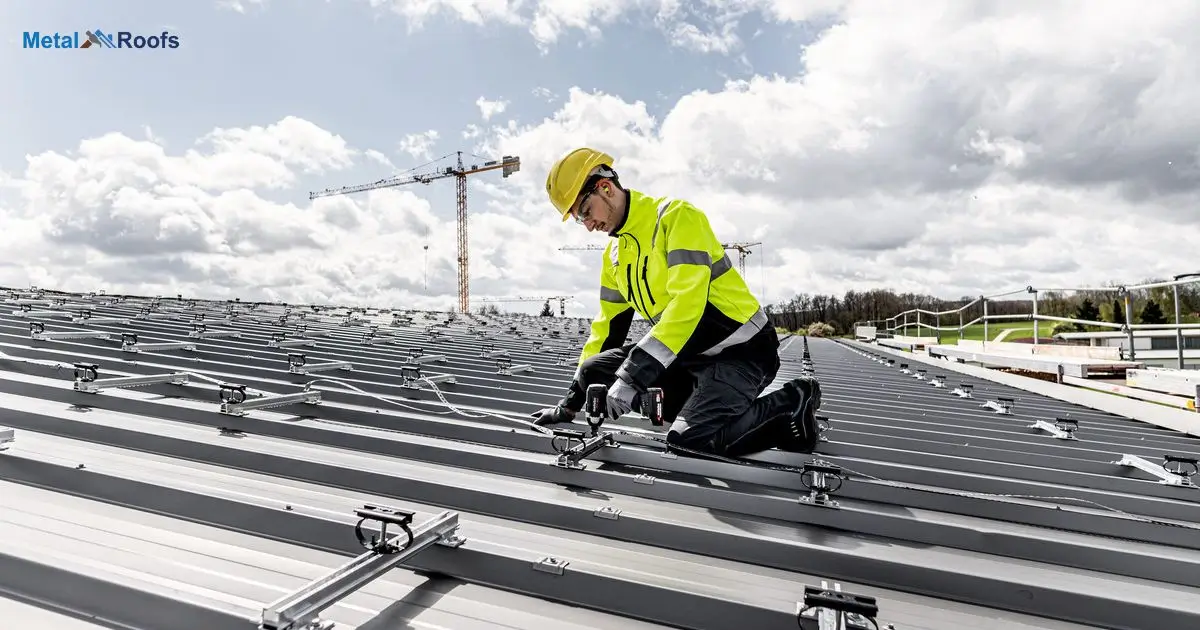A metal roof stays strong against dents with its durable material. You can prevent dents by avoiding heavy objects on the roof. Regular inspections help spot any potential issues early. Keeping branches trimmed also protects the roof from damage.
You can walk on a metal roof without denting it? Well, the answer lies in being cautious. Metal roofs can dent if subjected to heavy pressure, so it’s best to avoid unnecessary foot traffic. Trimming tree branches that could fall and cause damage is another smart move.
Protecting your metal roof from dents is all about being proactive. By minimizing foot traffic and keeping branches trimmed away from the mansard wall, you can prevent potential damage. Regular maintenance ensures your roof stays strong and dent-free for years to come.
Key Takeaways
- Exercise caution when walking on a metal roof to prevent dents.
- Minimize foot traffic to reduce the risk of damage.
- Trim overhanging tree branches to prevent them from causing dents.
- Regular maintenance and prompt repairs help maintain the roof’s integrity.
Metal Roof Grippers
When it comes to walking on a metal roof without denting it, metal roof grippers can be handy. These grippers provide traction, reducing the risk of slipping and causing damage. They evenly distribute weight, minimizing pressure points that could lead to dents. Using metal roof grippers adds an extra layer of protection for both you and your roof.
Metal roof grippers work by securely gripping onto the metal surface, ensuring stable footing. They are easy to attach and remove, making them convenient for occasional roof maintenance tasks. By investing in metal roof grippers, you can enhance safety and minimize the risk of denting your metal roof while walking on it.
Magnetic Boots For Metal Roofing
| Benefits of Magnetic Boots | Drawbacks of Magnetic Boots |
| Secure footing | May scratch or damage roof |
| Hands-free working | Potential for slipping |
| Easy to use | Weight can be cumbersome |
Curious about magnetic boots for metal roofing? These innovative accessories offer a secure grip, minimizing the risk of slips and falls. They provide added stability when walking on metal roofs, enhancing safety for workers. Magnetic boots are designed to adhere firmly to the metal surface, giving users confidence as they navigate rooftops.
With magnetic boots, navigating metal roofing becomes safer and more efficient. Their strong magnetic grip ensures stability even on slick surfaces, reducing the chance of accidents. Workers can move confidently across the roof, completing tasks with ease and peace of mind.
How To Prepare For Walking?

Preparing for walking on a metal roof is crucial. First, inspect the roof for any damage or loose materials. Next, choose appropriate footwear with good traction. Then, use a sturdy ladder to safely access the roof. Finally, walk slowly and evenly distribute your weight to avoid dents.
Check Weather Conditions
Before walking on a metal roof, check the weather forecast. Avoid walking on wet or icy roofs, as they can be slippery and dangerous. Choose a dry, clear day with mild temperatures for the safest conditions. Checking the weather ensures your safety and the effectiveness of your work on the roof.
Use Proper Safety Equipment
When preparing to walk on a metal roof, safety is paramount. Use proper safety equipment such as a harness and non-slip shoes. Ensure the ladder is secure and extend it at least 3 feet above the roof’s edge for easy access. Clear the roof of debris and check for any loose panels or sharp edges before walking.
Call A Professional If Necessary
Preparing to walk on a metal roof? Safety first. If unsure, call a professional roofer. They have the expertise and equipment to handle it safely. It’s worth the investment to avoid accidents and costly damage.
Proper Installation And Maintenance
Proper installation of a metal roof sets the foundation for its durability. Ensure it’s installed by experienced professionals to avoid future issues. Regular maintenance is crucial for keeping the roof in top condition. Inspect for loose fasteners or damaged panels periodically.
Maintenance tasks include cleaning debris and checking for rust or corrosion. Address any issues promptly to prevent them from worsening. By investing time and effort in proper installation and maintenance, you can extend the lifespan of your metal roof and minimize the risk of dents.
Choosing The Right Materials And Design

Selecting the right materials and design is crucial for a durable metal roof. Opt for high-quality metal that can withstand harsh weather conditions. Consider the design elements that complement your home’s architecture for both aesthetic appeal and functionality. Consult with professionals to ensure you choose materials and design that meet your needs.
The right materials and design can enhance the longevity and performance of your metal roof. Prioritize durability and weather resistance when selecting materials. Choose a design that not only looks great but also provides proper drainage and ventilation.
Benefits Of Metal Roofs
Metal roofs offer numerous benefits compared to traditional roofing materials such as asphalt shingles or wood shakes. Some of the key advantages of metal roofs include:
Durability: Metal roofs are highly durable and can withstand harsh weather conditions such as rain, snow, hail, and wind. They typically have a longer lifespan compared to other roofing materials, lasting 50 years or more with proper maintenance.
Longevity: Metal roofs have a longer lifespan than many other roofing materials, often lasting 2 to 3 times longer than asphalt shingles.
Low Maintenance: Metal roofs require minimal maintenance compared to other roofing materials. They are resistant to rot, mildew, and pests, and generally only require occasional cleaning to remove debris.
Energy Efficiency: Metal roofs are highly reflective, which helps to reduce heat absorption and keep your home cooler in hot climates. This can lead to lower energy bills for cooling.
Environmentally Friendly: Metal roofing is often made from recycled materials and is itself recyclable at the end of its lifespan, making it a sustainable roofing option. Metal roofs can often be installed over existing roofs, reducing the need for disposal of old roofing materials.
Fire Resistance: Metal roofs are non-combustible and have a Class A fire rating, making them highly resistant to fire. This can provide added safety and peace of mind for homeowners.
Weight: Metal roofs are lightweight compared to other roofing materials, which can reduce the strain on the structure of your home and may even allow for installation over existing roofs without reinforcement.
Aesthetic Appeal: Metal roofs come in a variety of styles, colors, and finishes, allowing homeowners to choose a look that complements their home’s architecture and enhances its curb appeal.
Insurance Benefits: Some insurance companies offer discounts on homeowners insurance premiums for homes with metal roofs due to their durability and resistance to damage from weather and fire.
Overall, metal roofs offer a range of benefits that make them an attractive option for homeowners looking for a long-lasting, low-maintenance roofing solution.
Metal Roofs Are Prone To Denting
Walking on a metal roof without denting it requires caution because metal roofs are prone to denting. Heavy pressure, such as walking or dropping heavy objects, can easily cause dents. Extreme weather conditions like hailstorms can also lead to dents on metal roofs.
To protect your metal roof from dents, it’s important to take preventive measures. Avoid unnecessary foot traffic and heavy objects on the roof to minimize the risk of dents. Regular inspections and prompt repairs are crucial to maintaining the roof’s integrity and preventing dents from occurring.
How To Inspect And Repair?

Inspecting and repairing your metal roof is vital for its longevity. Start by visually inspecting the roof for any signs of damage, such as dents or scratches. Use a ladder to safely access the roof and examine it closely. If you notice any issues, such as loose panels or damaged flashing, address them promptly to prevent further damage.
Repairing your metal roof can be straightforward with the right tools and materials. Use roofing sealant to fix minor leaks or cracks in the seams. For larger repairs, such as replacing damaged panels, consult a professional roofer. Ensure all repairs are done carefully to maintain the roof’s integrity and prevent future issues.
What Kind Of Shoes Are Best?
Choosing the right shoes matters. For walking on a metal roof, opt for flat, non-slippery soles. Sneakers or work boots with good traction are ideal. Avoid high heels or shoes with thin soles, as they can damage the roof or cause slipping. Prioritize safety and stability above style when selecting footwear for this task.
Rubber-Soled Shoes For Traction
Rubber-soled shoes offer excellent traction on metal roofs. They provide grip and stability, reducing the risk of slipping. Choose shoes with thick, durable rubber soles for the best traction. These shoes can help you walk safely and confidently on metal roofs.
Hiking Boots For Stability
For added stability, consider hiking boots. They offer ankle support and sturdy soles, ideal for rough terrain. Look for boots with good grip to prevent slipping on metal roofs. Hiking boots can provide the traction and stability needed for safe roof walking.
Sneakers For Soft Surfaces
When dealing with soft surfaces like grass or sand, sneakers are a smart choice. Look for sneakers with a firm sole to provide stability. Avoid shoes with deep treads that can trap debris or mud. Prioritize comfort and support for your feet when selecting sneakers for soft surfaces.
Types Of Metal Roofs
Metal roofs come in various types, each offering different aesthetics, durability, and benefits. Here are some common types:
Corrugated Metal Roofing: Typically made of galvanized steel or aluminum, corrugated metal roofing consists of wavy or ribbed panels. It’s lightweight, affordable, and durable, often used in agricultural and industrial buildings.
Standing Seam Metal Roofing: This type features raised seams that interlock to form a watertight seal. It’s popular in residential and commercial buildings due to its sleek appearance, durability, and resistance to leaks.
Metal Shingle/Shake Roofing: These mimic the look of traditional shingles or wooden shakes but are made of metal. They offer the appearance of traditional roofing materials with the added benefits of metal, such as durability and low maintenance.
Metal Tile Roofing: Metal tiles resemble traditional clay or concrete tiles but are made of metal. They offer similar aesthetics to traditional tiles but with the advantages of metal roofing, including longevity and fire resistance.
Stamped Metal Roofing: Stamped metal roofing allows for customization of designs and patterns, providing a unique aesthetic appeal. It’s often used in high-end residential and commercial buildings.
Copper Roofing: Copper roofs offer a distinctive appearance and develop a natural patina over time, giving them a unique, weathered look. While expensive, copper roofs are durable and can last for centuries with proper maintenance.
Zinc Roofing: Zinc roofing is durable, corrosion-resistant, and naturally weathers over time to develop a protective patina. It’s often chosen for its aesthetic appeal and long lifespan.
Aluminum Roofing: Aluminum roofs are lightweight, corrosion-resistant, and suitable for coastal areas or locations with high humidity. They are also recyclable and energy-efficient.
Galvalume Roofing: Galvalume is a steel substrate coated with an alloy of zinc and aluminum, providing excellent corrosion resistance. Galvalume roofing is durable and widely used in residential and commercial applications.
Steel Roofing: Steel roofs are strong, durable, and relatively affordable. They come in various profiles and finishes, making them suitable for a wide range of architectural styles.
Each type of metal roof has its own set of characteristics, so choosing the right one depends on factors such as budget, climate, aesthetics, and desired lifespan.
What Are The Common Myths?

Common myths about walking on a metal roof abound, but let’s debunk them. One myth suggests that metal roofs are indestructible, but they can dent under pressure. Another myth is that walking on a metal roof is safe at any time, which isn’t true due to potential damage risks.
It’s also a misconception that metal roofs can’t be damaged by falling objects. While they’re durable, heavy items can cause dents. Some believe that walking on a metal roof won’t cause any harm, but excessive foot traffic can lead to dents over time.
How To Repair Hail Damage
Repairing hail damage is essential to maintain the integrity of your roof. Begin by inspecting the roof for any signs of dents or punctures caused by hail. Use a ladder to safely access the roof and assess the extent of the damage. Once identified, carefully hammer out any dents using a rubber mallet to restore the roof’s smooth surface.
Next, seal any punctures or cracks with roofing cement to prevent leaks and further damage. Apply the cement generously over the damaged area, ensuring a tight seal. Smooth out the cement with a putty knife for a clean finish. Finally, conduct regular inspections and prompt repairs to address any new damage and keep your roof in top condition.
Frequently Asked Questions
Do Metal Roofs Dent When Walked On?
Metal roofs can dent when walked on, especially with incorrect or uneven weight distribution.
Will It Damage A Metal Roof To Walk On It?
Walking on a metal roof can potentially damage it if not done correctly.
Is It Ok To Stand On A Metal Roof?
Standing on a metal roof is generally okay, but caution is key to avoid damage.
Conclusion
Walking on a metal roof can be safe if done carefully. Distribute your weight evenly and avoid heavy impact to prevent dents. Using a sturdy ladder for access can also help maintain the roof’s integrity. To consult the manufacturer to ensure your actions don’t void the warranty.
Overall, metal roofs are durable and can withstand some weight. It’s essential to take precautions to avoid damaging them. By being mindful of how you walk on a metal roof, you can enjoy its benefits without worry.











